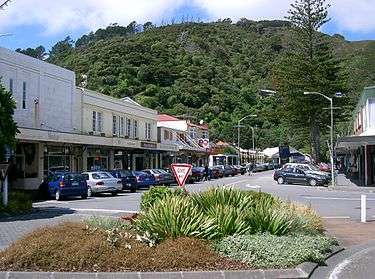Te Tai Tonga


Te Tai Tonga is a New Zealand parliamentary Māori electorate, returning one Member of Parliament to the New Zealand House of Representatives. The current MP for Te Tai Tonga is Rino Tirikatene of the Labour Party, who in 2011 defeated Rahui Katene of the Māori Party, who in turn had won the seat in 2008.
Population centres
Te Tai Tonga is by far the largest of the seventy-one electorates of New Zealand, covering all of the South Island, Stewart Island, the Chatham Islands, all the islands in the Southern Ocean and a large part of the Wellington urban area, namely Wellington City as far as Johnsonville, and Petone, Lower Hutt and Eastbourne from the Hutt Valley. Besides Wellington, the main centres in te Tai Tonga are Dunedin, Christchurch, Nelson, Timaru, Invercargill, Queenstown and Oamaru.
Te Tai Tonga's size was marginally decreased after a review of boundaries in 2007, when the suburbs of Naenae and Taitā were moved into Ikaroa-Rāwhiti.[1] The 2013/14 redistribution did not further alter the boundaries of the electorate.[2]
The main iwi of Te Tai Tonga are Ngāi Tahu/Kai Tahu, Kāti Mamoe and Waitaha, and in the North Island, Te Āti Awa ki Whakarongotai, Ngāti Toa Rangatira and Ngāti Poneke,[3] which is not iwi in the traditional sense, but an urban pan-tribal grouping. The Chatham Islands was invaded by members of Ngāti Mutunga and Ngāti Tama, and their descendants live there today, alongside the indigenous Moriori.
History

The boundaries of Te Tai Tonga have a lot in common with the seat of Southern Maori that it superseded in 1996 with the introduction of Mixed Member Proportional (MMP) voting and an increase in the number of Māori electorates from four to five. The main difference involves the separation of the Wairarapa and Hawke's Bay into seats wholly located in the North Island - initially Te Puku O Te Whenua, and since 1999 Ikaroa-Rāwhiti. The voting patterns of Te Tai Tonga reflect the adaptation of Te Tai Tonga voters to proportional representation. Whetū Tirikatene-Sullivan had served as Southern Maori's representative in Parliament during the terms of five different governments and nine Prime Ministers, but the New Zealand First Party challenger Tū Wyllie tipped her out of the seat in 1996, as sixty years of Labour Party control of the (then) four Māori electorates ended.
In 1999 New Zealand First lost its electoral footing after an unpopular term in office, firstly as junior government-coalition partner and then following an internal split in the party, with much of the party's original parliamentary caucus leaving the party ("waka-jumping") to prop up the government of Jenny Shipley (although Wyllie himself did not join the breakaway group). Along with a drop in the New Zealand First party vote from thirteen to four percent nationwide came the return of the Māori electorates to Labour and the election of Mahara Okeroa to Parliament as the Labour Party MP for Te Tai Tonga.
A political difference of opinion between many Māori and the Labour Party emerged in 2004, when Helen Clark's Labour government introduced the Seabed and Foreshore Bill, claiming the coastline for the Crown and in the process providing the catalyst for the launch of the Māori Party (7 July 2004), which went on to win four of the seven Māori seats (but not the plurality of the party votes cast in those seats) at the 2005 general election. Te Tai Tonga did not form part of this electoral sea-change, with Okeroa's majority slashed from 8,000 to around 2,500 despite his facing two fewer contenders than in 2002. At the same time, voters in the seat used the left-hand side of the ballot paper to up Labour's share of the party vote from 52 to 57 percent and to help re-elect Clark's Labour government (possibly due to the campaign stance of National Party leader Don Brash).
Rahui Katene won the electorate for the Māori Party in the 2008 election, defeating the incumbent.[4] Tirikatene won the electorate in 2011 with a margin of 1,475 votes.[5] Tirikatene significantly increased his majority in the 2014 election.[6]
Members of Parliament
Key
| Election | Winner | |
|---|---|---|
| 1996 election | Tu Wyllie | |
| 1999 election | Mahara Okeroa | |
| 2002 election | ||
| 2005 election | ||
| 2008 election | Rahui Katene | |
| 2011 election | Rino Tirikatene | |
| 2014 election | ||
List MPs
Members of Parliament elected from party lists in elections where that person also unsuccessfully contested the Te Tai Tonga electorate. Unless otherwise stated, all MPs terms began and ended at general elections.
| Election | Winner | |
|---|---|---|
| 2005 election | Metiria Turei | |
Election results
2011 election
| General election 2011: Te Tai Tonga[5] | |||||||||
|---|---|---|---|---|---|---|---|---|---|
|
Notes: Green background denotes the winner of the electorate vote.
| |||||||||
| Party | Candidate | Votes | % | ±% | Party Votes | % | ±% | ||
| Labour | Rino Tirikatene | 6,786 | 40.62 | -1.18 | 6,791 | 38.52 | -11.06 | ||
| Māori | |
5,311 | 31.79 | -15.51 | 2,379 | 13.49 | -8.76 | ||
| Green | Dora Roimata Langsbury | 2,546 | 15.24 | +4.34 | 2,789 | 15.82 | +8.61 | ||
| Mana | Clinton Dearlove | 1,360 | 8.14 | +8.14 | 1,043 | 5.92 | +5.92 | ||
| Legalise Cannabis | Emma-Jane Mihaere Kingi | 703 | 4.21 | +4.21 | 230 | 1.30 | +0.26 | ||
| National | 2,631 | 14.92 | +3.78 | ||||||
| NZ First | 1,544 | 8.76 | +3.20 | ||||||
| Conservative | 120 | 0.68 | +0.68 | ||||||
| United Future | 43 | 0.24 | +0.05 | ||||||
| ACT | 32 | 0.18 | -0.48 | ||||||
| Democrats | 16 | 0.09 | +0.06 | ||||||
| Alliance | 7 | 0.04 | -0.03 | ||||||
| Libertarianz | 4 | 0.02 | +0.003 | ||||||
| Informal votes | 840 | 268 | |||||||
| Total Valid votes | 16,706 | 17,629 | |||||||
| Labour gain from Māori | Majority | 1,475 | 8.83 | +14.34 | |||||
Electorate (as at 26 November 2011): 31,933[7]
2008 election
| General election 2008: Te Tai Tonga[8] | |||||||||
|---|---|---|---|---|---|---|---|---|---|
|
Notes: Green background denotes the winner of the electorate vote.
| |||||||||
| Party | Candidate | Votes | % | ±% | Party Votes | % | ±% | ||
| Māori | Rahui Katene | 9,011 | 47.30 | 4,414 | 22.26 | ||||
| Labour | |
7,962 | 41.80 | 9,833 | 49.58 | ||||
| Green | Dora Roimata Langsbury | 2,076 | 10.90 | 1,430 | 7.21 | ||||
| National | 2,210 | 11.14 | |||||||
| NZ First | 1,102 | 5.56 | |||||||
| Legalise Cannabis | 207 | 1.04 | |||||||
| Bill and Ben | 158 | 0.80 | |||||||
| ACT | 131 | 0.66 | |||||||
| Progressive | 122 | 0.62 | |||||||
| Family Party | 76 | 0.38 | |||||||
| Kiwi | 69 | 0.35 | |||||||
| United Future | 38 | 0.19 | |||||||
| Alliance | 14 | 0.07 | |||||||
| Workers Party | 13 | 0.07 | |||||||
| Democrats | 6 | 0.03 | |||||||
| Libertarianz | 4 | 0.02 | |||||||
| Pacific | 4 | 0.02 | |||||||
| RAM | 2 | 0.01 | |||||||
| RONZ | 0 | 0.00 | |||||||
| Informal votes | 656 | 261 | |||||||
| Total Valid votes | 19,049 | 19,833 | |||||||
| Māori gain from Labour | Majority | 1,049 | 5.51 | ||||||
2005 election
| General election 2005: Te Tai Tonga[9] | |||||||||
|---|---|---|---|---|---|---|---|---|---|
|
Notes: Green background denotes the winner of the electorate vote.
| |||||||||
| Party | Candidate | Votes | % | ±% | Party Votes | % | ±% | ||
| Labour | |
9,015 | 47.23 | -15.94 | 11,485 | 57.89 | |||
| Māori | Monte Ohia | 6,512 | 34.12 | +34.12 | 3,481 | 17.55 | |||
| Green | Metiria Turei | 2,296 | 12.03 | 1,283 | 6.47 | ||||
| Progressive | Russell Caldwell | 705 | 3.69 | 169 | 0.85 | ||||
| Destiny | Maru Samuel | 559 | 2.93 | 235 | 1.18 | ||||
| National | 1,462 | 7.37 | |||||||
| NZ First | 1,240 | 6.25 | |||||||
| United Future | 211 | 1.06 | |||||||
| Legalise Cannabis | 159 | 0.80 | |||||||
| ACT | 58 | 0.29 | |||||||
| Alliance | 14 | 0.07 | |||||||
| Christian Heritage | 9 | 0.05 | |||||||
| Democrats | 8 | 0.04 | |||||||
| Family Rights | 7 | 0.04 | |||||||
| Libertarianz | 4 | 0.02 | |||||||
| One NZ | 4 | 0.02 | |||||||
| 99 MP | 3 | 0.02 | |||||||
| Direct Democracy | 3 | 0.02 | |||||||
| RONZ | 3 | 0.02 | |||||||
| Informal votes | 655 | 322 | |||||||
| Total Valid votes | 19,087 | 19,838 | |||||||
| Labour hold | Majority | 2,503 | 13.11 | -38.99 | |||||
1996 election
| General election 1996: Te Tai Tonga[10][11][12] | |||||||||
|---|---|---|---|---|---|---|---|---|---|
|
Notes: Green background denotes the winner of the electorate vote.
| |||||||||
| Party | Candidate | Votes | % | ±% | Party Votes | % | ±% | ||
| NZ First | Tutekawa Wyllie | 7,657 | 37.99 | 6,576 | 32.47 | ||||
| Labour | |
7,372 | 36.58 | 7,167 | 35.39 | ||||
| Alliance | Hone Kaiwai | 1,916 | 9.51 | 2,290 | 11.31 | ||||
| Independent | Eva Rickard | 1,220 | 6.05 | ||||||
| National | Cliff Bedwell | 1,115 | 5.53 | 1,732 | 8.55 | ||||
| Independent | Honty Whaanga-Morris | 873 | 4.33 | ||||||
| Legalise Cannabis | 896 | 4.42 | |||||||
| Mana Māori | 667 | 3.29 | |||||||
| Christian Coalition | 441 | 2.18 | |||||||
| ACT | 232 | 1.15 | |||||||
| United NZ | 52 | 0.26 | |||||||
| McGillicuddy Serious | 37 | 0.18 | |||||||
| Te Tawharau | 35 | 0.17 | |||||||
| Progressive Green | 33 | 0.16 | |||||||
| Animals First | 28 | 0.14 | |||||||
| Green Society | 22 | 0.11 | |||||||
| Natural Law | 12 | 0.06 | |||||||
| Superannuitants & Youth | 9 | 0.04 | |||||||
| Ethnic Minority Party | 7 | 0.03 | |||||||
| Conservatives | 5 | 0.02 | |||||||
| Libertarianz | 4 | 0.02 | |||||||
| Advance New Zealand | 3 | 0.01 | |||||||
| Asia Pacific United | 2 | 0.01 | |||||||
| Informal votes | 279 | 182 | |||||||
| Total Valid votes | 20,153 | 20,250 | |||||||
| NZ First win new seat | Majority | 285 | 1.41 | ||||||
References
- ↑ Report of the Representation Commission 2007 (PDF). Representation Commission. 14 September 2007. p. 11. ISBN 978-0-477-10414-2. Retrieved 2 October 2014.
- ↑ Report of the Representation Commission 2014 (PDF). Representation Commission. 4 April 2014. p. 11. ISBN 978-0-477-10414-2. Retrieved 2 October 2014.
- ↑ Te Puni Kōkiri - In Your Region - Te Whanganui ā Tara
- ↑ Macintosh, Rob (13 September 2011). "Battle for Maori seat is under way". The Marlborough Express. Retrieved 29 November 2011.
- 1 2 "Official Count Results -- Te Tai Tonga". Electoral Commission. 10 December 2011. Retrieved 3 October 2014.
- ↑ "Official Count Results -- Te Tai Tonga". Electoral Commission. 21 September 2014. Retrieved 3 October 2014.
- ↑ "Enrolment statistics". Electoral Commission. 26 November 2011. Retrieved 28 November 2011.
- ↑ 2008 election results
- ↑ 2005 election results
- ↑ "Electorate Candidate and Party Votes Recorded at Each Polling Place - Te Tai Tonga" (PDF). Retrieved 4 August 2013.
- ↑ Party Lists of Successful Registered Parties
- ↑ Party Lists of Unsuccessful Registered Parties
External links
- Electorate Profile Parliamentary Library
Coordinates: 43°36′00″S 172°00′00″E / 43.6000°S 172.0000°E
